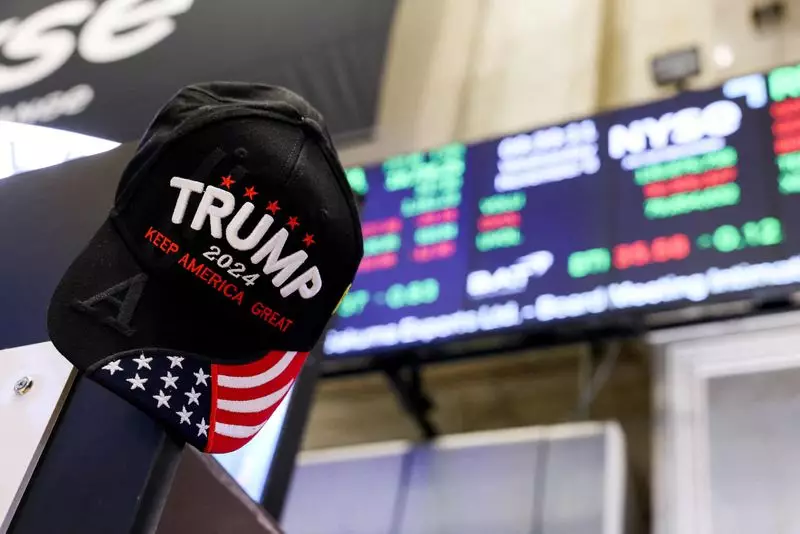In the world of finance, the scrutiny on the U.S. stock market continues to deepen, especially as it extends its advantages over global counterparts. The performance metrics indicate a significant gap, as U.S. stocks have recently outperformed international indices, driven by numerous influential factors, including a resilient economy, robust corporate earnings, and favorable political climates. However, the road ahead is fraught with risks, from potential trade wars to increasing federal deficits, which necessitate a thorough examination of the underlying elements propelling this market dominance.
The S&P 500 has showcased impressive gains, exceeding a 24% increase in 2024 alone. This performance places it significantly ahead of benchmarks in regions such as Europe and Asia. The current valuation of U.S. stocks, positioned at approximately 22 times future earnings, reflects a premium compared to other global markets, reaching its highest level in over twenty years. This discrepancy in valuation becomes even more pronounced when juxtaposed against the MSCI index, which encompasses over 40 other countries. Such an extensive valuation gap raises questions about the sustainability of U.S. stock performance going forward.
Market dynamics reveal that the disparity in growth trajectories has been emerging for over a decade, yet the recent year has accentuated this trend, primarily fueled by strong corporate profit growth. The U.S. economy remains a beacon of resilience, particularly within the technology sector, which has seen a surge in investor excitement around innovations, particularly those related to artificial intelligence. Companies like Nvidia have witnessed dramatic stock increases, underscoring the impact of technological advancements on market performance.
At the core of this analysis is the impending implementation of President-elect Donald Trump’s economic agenda, which is perceived by some market participants as a catalyst for further bullish behavior in U.S. equities. His proposed policies, encompassing tax cuts and deregulation, are viewed as solutions capable of fostering economic growth. However, concerns linger regarding the implications of such policies, including their potential to heighten inflation or incite trade disputes.
According to Venu Krishna, head of U.S. equity strategy at Barclays, the pro-growth policies ensconced within Trump’s platform may create favorable conditions for U.S. stock performance in the foreseeable future, specifically in 2025. Following the November 5 election, there was a noticeable trend of capital flowing towards U.S. equities; funds in this segment saw inflows exceeding $80 billion, while European and emerging markets recorded outflows.
A pivotal factor propelling U.S. stocks is the robust outlook for corporate earnings. Forecasts suggest that S&P 500 company earnings will rise by nearly 10% in the current year, followed by anticipated growth exceeding 14% in 2025. In stark contrast, European firms are expected to gross earnings growth of just 1.8% for this year, significantly hampering their ability to compete with their American counterparts. The dominance of large tech corporations within the U.S. economy underscores this advantage, with companies like Apple, Microsoft, Amazon, and Google commanding a combined market valuation far surpassing the entire European STOXX 600 index.
Moreover, projections from the International Monetary Fund indicate a healthy growth trajectory for the U.S. economy, with anticipated growth rates of 2.8% in 2024 and 2.2% in 2025, far outpacing other developed economies. Even amid discussions of increasing tariffs on imports—a measure that could bring about retaliatory actions—the sentiment among many analysts leans towards continued favorability for U.S. equities.
Despite the prevailing optimism, analysts caution against the emergence of an all-out trade war, particularly with nations like China and various European countries. Such conflicts could detrimentally impact U.S. economic growth and potentially stoke inflation. For instance, strategic analysts assert that retaliatory tariffs aimed at U.S. exports could severely undermine the performance of the S&P 500.
In addition to international tensions, concerns surrounding federal deficits and their implications on long-term economic stability have also sparked debates. The recent rise in yields on U.S. government bonds indicates a growing apprehension among investors, particularly as they focus on the long-term feasibility of expansive fiscal policies.
Ultimately, the landscape of U.S. equities appears robust for the moment, driven by groundbreaking corporate growth, technological innovation, and a favorable economic environment. However, underlying risks remain potent, particularly those related to external economic relations and domestic fiscal health. Investors are advised to approach this thriving environment with a judicious perspective, recognizing that momentum can be fleeting in the unpredictable realm of global finance. The gap in valuation between U.S. stocks and their international counterparts may eventually lead to a recalibration of market dynamics, necessitating astute investment strategies in the coming months.

